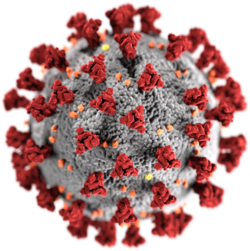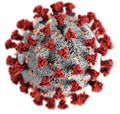پرونده:SARS-CoV-2 (CDC-23312).png

اندازهٔ این پیشنمایش: ۶۳۱ × ۶۰۰ پیکسل. کیفیتهای دیگر: ۲۵۳ × ۲۴۰ پیکسل | ۵۰۵ × ۴۸۰ پیکسل | ۸۰۸ × ۷۶۸ پیکسل | ۱٬۰۷۷ × ۱٬۰۲۴ پیکسل | ۲٬۳۶۷ × ۲٬۲۵۰ پیکسل.
پروندهٔ اصلی (۲٬۳۶۷ × ۲٬۲۵۰ پیکسل، اندازهٔ پرونده: ۳٫۲۷ مگابایت، نوع MIME پرونده: image/png)
این پرونده از ویکیانبار است و ممکن است توسط پروژههای دیگر هم استفاده شده باشد. توضیحات موجود در صفحهٔ توضیحات پرونده در آنجا، در زیر نشان داده شده است.
خلاصه
| توضیحSARS-CoV-2 (CDC-23312).png |
Deutsch: Diese Abbildung, die in den Zentren für die Kontrolle und Prävention von Krankheiten (CDC) erstellt wurde, zeigt die ultrastrukturelle Morphologie des neuartigen Coronavirus 2019 (2019-nCoV). Beachten Sie die Spitzen, die die äußere Oberfläche des Virus schmücken und bei elektronenmikroskopischer Betrachtung das Aussehen einer das Virion umgebenden Korona vermitteln. Dieses Virus wurde als Ursache für einen Ausbruch einer Atemwegserkrankung identifiziert, die erstmals in Wuhan, China, festgestellt wurde. English: This illustration, created at the Centers for Disease Control and Prevention (CDC), reveals ultrastructural morphology exhibited by the 2019 Novel Coronavirus (2019-nCoV). Note the spikes that adorn the outer surface of the virus, which impart the look of a corona surrounding the virion, when viewed electron microscopically. This virus was identified as the cause of an outbreak of respiratory illness first detected in Wuhan, China. Español: Esta ilustración, creada en los Centros para el Control y la Prevención de Enfermedades (CDC), revela la morfología ultraestructural exhibida por el nuevo coronavirus 2019 (2019-nCoV). Tenga en cuenta los picos que adornan la superficie exterior del virus, que imparten el aspecto de una corona que rodea al virión, cuando se observa al microscopio electrónico. Este virus fue identificado como la causa de un brote de enfermedad respiratoria detectado por primera vez en Wuhan, China. Français : Cette illustration, créée aux Centres pour le Contrôle et la Prévention des Maladies (CDC), révèle la morphologie ultrastructurale exhibée par le nouveau coronavirus 2019 (2019-nCoV). Notez les spicules ornant la surface externe du virus qui donnent l'apparence d'une couronne entourant le virion, lorsque celui-ci est observé au microscope électronique. Ce virus a été identifié comme étant la cause d'une épidemie de maladie respiratoire dont le premier cas a été rencensé à Wuhan, en Chine. Italiano: Questa illustrazione, creata dai Centers for Disease Control and Prevention (CDC), rivela la morfologia ultrastrutturale mostrata dal "2019 Novel Coronavirus" (2019-nCoV). Si notino i chiodini che costellano la superficie esterna del virus e che gli conferiscono l'aspetto di una corona che circonda il virione, vista al microscopio elettronico. Questo virus è stato identificato come la causa di un'epidemia di affezioni respiratorie registrate per la prima volta a Wuhan, in Cina. |
||
| تاریخ | |||
| منبع |
https://phil.cdc.gov/Details.aspx?pid=23312
|
||
| پدیدآور | CDC/ Alissa Eckert, MS; Dan Higgins, MAM | ||
| دیگر نسخهها |
     |
اجازهنامه
| Public domainPublic domainfalsefalse |
This file is a work of the Centers for Disease Control and Prevention, part of the United States Department of Health and Human Services, taken or made as part of an employee's official duties. As a work of the U.S. federal government, the file is in the public domain.
|
 |
عنوان
شرحی یکخطی از محتوای این فایل اضافه کنید
Computer render of SARS-CoV-2 virus
trojrozmerný model coronavíru SARS-CoV-2
ကူးစက်ရောဂါပိုး
SARS-CoV-2(2019年新型コロナウイルス)のコンピュータレンダリング画像
在疾病控制与预防中心(CDC)创建的此图揭示了2019年新型冠状病毒(SARS-CoV-2)展示的超微结构形态。 注意,用电子显微镜观察时,装饰在病毒外表面的尖峰会赋予病毒体周围的电晕外观。 该病毒被确定为在中国武汉首次发现的呼吸道疾病暴发原因。
2019년 발견된 급성 코로나바이러스 2호 (SARS-CoV-2)를 컴퓨터로 정리한 사진
Computer-Rendering des SARS-CoV-2-Virus
Rendu informatique du virus SARS-CoV-2
Renderització per ordinador del virus SARS-CoV-2
gambaran komputer dari virus SARS-CoV-2
صورية مبنية من قبل الحاسب لفايروس سارس-كوف-2
Virus
Picture of SARS-CoV-2, created by CDC.
Ricostruzione al computer del virus SARS-CoV-2
آیتمهایی که در این پرونده نمایش داده شدهاند
توصیفها
۲۰ نوامبر 2021
image/png
تاریخچهٔ پرونده
روی تاریخ/زمانها کلیک کنید تا نسخهٔ مربوط به آن هنگام را ببینید.
| تاریخ/زمان | بندانگشتی | ابعاد | کاربر | توضیح | |
|---|---|---|---|---|---|
| کنونی | ۱۳ ژوئیهٔ ۲۰۲۳، ساعت ۲۰:۲۱ |  | ۲٬۳۶۷ در ۲٬۲۵۰ (۳٫۲۷ مگابایت) | wikimediacommons>Obscure2020 | Optimized with OxiPNG and ZopfliPNG. |
کاربرد پرونده
صفحهٔ زیر از این تصویر استفاده میکند:
